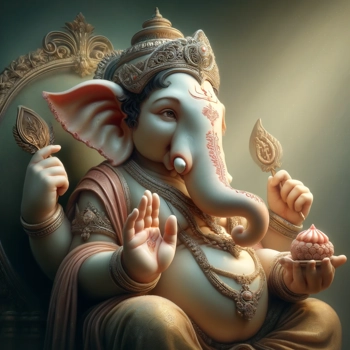



Vinayaka Vratam, also known as Ganesh Chaturthi Vratam, is a significant Hindu observance dedicated to Lord Ganesha, the remover of obstacles and the god of wisdom, prosperity, and good fortune. Celebrated with great devotion and enthusiasm, this vratam is observed on the Chaturthi (fourth day) of the Shukla Paksha (waxing phase of the moon) in the Hindu month of Bhadrapada, which typically falls in August or September. The Vinayaka Vratam marks the birth of Lord Ganesha and involves various rituals, including the installation of Ganesha idols, elaborate pujas, and the chanting of mantras and bhajans. Devotees across India and the world observe this vratam to seek the blessings of Lord Ganesha for success, wisdom, and the removal of obstacles in their lives.

The Vinayaka Vratam holds deep spiritual and cultural significance in Hinduism. It is believed that observing this vratam with sincerity and devotion pleases Lord Ganesha, who blesses his devotees with wisdom, prosperity, and success. The vratam symbolizes the importance of starting any new endeavor with the worship of Lord Ganesha to ensure its smooth progress and successful completion. It is also a reminder of the divine power that guides and supports individuals in overcoming challenges and achieving their goals.
Removal of Obstacles: Devotees believe that worshipping Lord Ganesha during Vinayaka Vratam helps in removing obstacles from their personal and professional lives.
Blessings of Wisdom and Knowledge: Lord Ganesha is revered as the god of wisdom and intellect. Observing the vratam is believed to enhance one’s intellectual capabilities and decision-making skills.
Prosperity and Success: By performing the Vinayaka Vratam, devotees seek blessings for prosperity, wealth, and success in all their endeavors.
Spiritual Growth: The rituals and prayers performed during the vratam encourage spiritual reflection and growth, bringing the devotee closer to the divine.
Peace and Harmony: The vratam fosters an atmosphere of peace and harmony in the household, as it is believed that Lord Ganesha brings calmness and positivity.
Fulfillment of Wishes: Many devotees observe the Vinayaka Vratam with the hope of fulfilling specific desires or wishes, believing that Lord Ganesha will grant them if approached with pure intentions.
Family Well-being: The vratam is often observed by entire families, which strengthens family bonds and ensures the well-being and happiness of all members.
By participating in the Vinayaka Vratam with dedication, devotees not only honor Lord Ganesha but also invite his divine presence into their lives, leading to a journey of spiritual and material fulfillment.
Performing the Vinayaka Vratam involves specific rituals and offerings to invoke the blessings of Lord Ganesha. Here is a detailed step-by-step guide to performing the vratam:
Clean the House: Begin by thoroughly cleaning your home, especially the area where the puja will be performed. This symbolizes the removal of impurities and the preparation of a sacred space for Lord Ganesha.
Set Up the Puja Altar: Arrange a clean, decorated cloth or asana (seat) on a raised platform for the idol or picture of Lord Ganesha. Place a small mound of rice or wheat as the base and then install the Ganesha idol on it.
Gather Puja Items: Ensure you have all the necessary items for the puja, including flowers, turmeric, kumkum (vermillion), sandalwood paste, betel leaves, betel nuts, coconuts, fruits, sweets (like modaks), incense sticks, camphor, diya (lamp), and puja thali.
Purification (Achamanam): Sprinkle water on yourself and chant purification mantras to cleanse your body and mind. This process helps you focus and prepare for the ritual.
Sankalpa (Intention): After purification, take some water in your right hand, chant the Sankalpa mantra, and express your intention to perform the Vinayaka Vratam for the blessings of Lord Ganesha. Offer the water to the earth.
Dhyana (Meditation): Close your eyes and meditate on the form of Lord Ganesha, visualizing his divine presence. Chant the Ganesha Dhyanam mantra or other prayers to invoke his blessings.
Avahana (Invocation): Using flowers or akshata (rice mixed with turmeric), invite Lord Ganesha to reside in the idol or picture for the duration of the puja by chanting the Avahana mantra.
Panchamrit Abhishekam (Bathing the Idol): Perform abhishekam (ritual bath) to the idol using five sacred ingredients (milk, curd, honey, ghee, and sugar) or simply with water.
Alankaram (Decoration): After the abhishekam, clean the idol and adorn it with new clothes, flowers, garlands, and sandalwood paste.
Pranapratishtha (Infusion of Life): Chant mantras to infuse life into the idol, symbolically bringing Lord Ganesha’s presence into it.
Arghya, Padya, and Achamana: Offer water to wash Lord Ganesha’s feet, hands, and mouth, symbolizing hospitality.
Naivedya (Offering of Food): Offer fruits, sweets (especially modaks, which are Lord Ganesha’s favorite), and other food items as Naivedya. These offerings are later shared as prasad.
Tambulam (Betel Leaves and Nuts): Offer betel leaves, betel nuts, and dakshina (coins) to Lord Ganesha.
Recite Ganesha Mantras: Chant powerful Ganesha mantras like "Om Gan Ganapataye Namah" or the Ganesha Atharvashirsha. Recite the 108 names of Lord Ganesha (Ganesha Ashtottara Shatanamavali).
Aarti: Perform the aarti using a lit camphor or a ghee lamp, moving it in a circular motion in front of the idol while singing the Ganesha Aarti song. This signifies the culmination of the puja.
Pradakshina (Circumambulation): Walk around the idol three times in a clockwise direction, symbolizing respect and devotion.
Namaskara (Prostration): Bow down and offer your prayers, seeking the blessings of Lord Ganesha.
Offering Prasad: After the puja, offer the Naivedya to all participants. This is considered sacred and is believed to carry the blessings of Lord Ganesha.
Visarjan (Farewell): After the puja, perform a small prayer to bid farewell to Lord Ganesha, thanking him for his presence and blessings. If a clay idol was used, it is traditionally immersed in water (preferably in a river or ocean) as a symbolic return to nature.
Final Prayers: End the puja by chanting the closing prayers and seeking forgiveness for any mistakes made during the rituals.
Sharing the Blessings: Distribute the prasad among family members, neighbors, and friends, sharing the blessings of Lord Ganesha.
By following these steps with devotion and sincerity, devotees can perform the Vinayaka Vratam successfully and receive the divine blessings of Lord Ganesha for prosperity, wisdom, and the removal of obstacles.